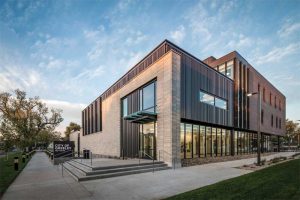by John Chamberlin

Abundance of choice is evident in today’s landscape of commercial cladding materials. Ranging from metal and brick to stone, exterior insulation finish system (EIFS), and fiber cement, architects and building owners can align their aesthetic visions in several ways to create beautiful buildings finished with a mix of cladding types. However, preserving the integrity of those mixed-media façades is largely about what goes on behind the walls. With the variety of cladding materials available today, and designers’ penchants to combine styles and textures, it is essential to specify building envelope controls that are compatible with multiple cladding types. This balancing act between aesthetic preferences and air and moisture management is where gypsum-integrated water-resistive barrier-air barrier (WRB-AB) sheathings shine.
These integrated materials streamline the entire construction process when different cladding selections are specified. Multi-component wall assemblies with separate WRB and AB layers call for advance work by designers who need to determine proper wall assembly attachments, as well as maintaining a single plane of insulation and weather protection for varying thicknesses of cladding. The separate layers of protection (i.e. WRB and AB) turn into additional levels of complexity for design and construction. Opting for an integrated sheathing system offers simplification and continuity of the air-moisture barrier.
Additionally, integrated gypsum offers more consistency in the WRB thickness and reduces field application issues. Designers need only concern themselves with joints and seams, rough openings, and penetration treatments.
Challenges of separate components
In conventional wall assembly design, separate products may be used for sheathing, WRB, and AB. Thermal control elements like continuous insulation (ci) add another layer of material-selection complexity. Exterior sheathing provides the essential support needed to make the barrier layers effective in multi-component cladding systems, and the individual materials must work symbiotically to achieve their overall objectives (consult “Considerations in the Design of Cladding Systems with Continuous Exterior Insulation” by Mar J. Klos).
However, assessing an individual material’s compatibility for thermal, vapor, air, and water/rain control layers can complicate the design. Gypsum-integrated options resolve the complexity more than non-integrated materials, when looking at the half-a-dozen criteria designers must consider, including weather conditions, fastener requirements, and exposure allowances (Figure 1). Further, an incompatible material can threaten the wall assembly’s performance.
Another item to consider is the interface between cladding materials and the WRB. Some claddings, like EIFS, require adhesive and chemical compatibility between their adhesive means of attachment and the WRB. Depending on the configuration, attachment method, and drainage details, the cladding may also influence the location and/or effectiveness of the drainage plane in an exterior wall assembly.
As a system, integrated sheathing starts with either wood or gypsum, modified through proprietary manufacturing processes, to produce sheathings that also act as WRBs and air barrier materials. Once the sheathing is installed, a complete and continuous system is created by sealing areas of discontinuity with tape or liquid flashing products. An integral WRB gypsum sheathing can act as a drainage plane without concerns for proper sequencing or shingle-lapping, which come with other technologies. However, the interface between the cladding and the WRB should still be reviewed.
Metal panels
Metal panels have become a popular cladding choice for accent or whole-building applications, but heat can build up behind them. As a result, when using liquid-applied or self-adhered WRBs and ABs in conjunction with metal, wall assembly designers need to have an understanding of the in-service temperature limitations of those barriers, which can be as high as 93 C (200 F), depending on the type of building and the kind, design, and location of the metal panel on the structure. Anecdotally, observations made when cladding choice causes a wall assembly to extend beyond the WRB’s temperature limitations indicate delamination, emulsification, or leaching of liquid materials in high-heat situations. Some liquid-applied or self-adhered WRBs and ABs are designed for higher temperatures. However, this sub-category of products underscores the complexity involved in choosing layers for multi-component systems.




